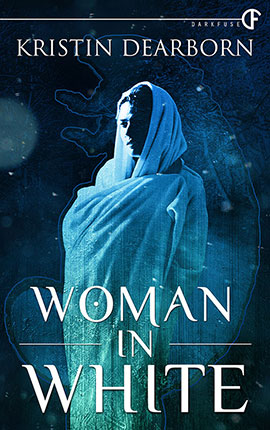Posted on Mar 22, 2016 by
Nick
This week on The Scariest Part, I’m delighted to have Kristin Dearborn as my guest. An up-and-coming horror author I’m sure you’ll all be hearing more about soon, her new novella is Woman in White. Here’s the publisher’s description:
Rocky Rhodes, Maine.
As a fierce snowstorm descends upon the sleepy little town, a Good Samaritan stops to help a catatonic woman sitting in the middle of the icy road, and is never seen or heard from again. When the police find his car, it is splattered in more blood than the human body can hold.
While the storm rages on, the wave of disappearances continue, the victims sharing only one commonality: they are all male. Now it’s up to three young women to figure out who or what is responsible: a forensic chemist, a waitress struggling with an abusive boyfriend, and a gamer coping with the loss of her lover.
Their search will lead them on a journey filled with unspeakable horrors that are all connected to a mysterious Woman in White.
And now, let’s hear what the scariest part was for Kristin Dearborn:
Woman in White is a winter novella in the vein of Christopher Golden’s Snowblind, Stephen King’s Dreamcatcher, or Ron Malfi’s Snow. A lifelong resident of New England, I am intimately aware of what a drag winter is, with the long, dark nights and everything muffled and muted by a blanket of snow. Don’t get me wrong. On a sunny winter day, it’s like the whole world is covered in glitter. You can ski, snowshoe, build a snowman, and the blue of a winter sky is blinding and brilliant. It’s the gloomy days that get to you. The days where you can’t tell where the sky ends and the snow begins because everything is the same flat grey. Nighttime goes on seemingly forever, and for most of us there are months where you go to work before the sun is up and get home as the sun is setting.
But the winter isn’t the scariest part of my novella.
The book tells the story of three young women in a tiny Maine town in winter, each of whom is battling her own figurative demons. One of the characters, Angela, has finally left her abusive boyfriend. Just out of high school, she found herself knocked up. She realized she couldn’t have Nate’s child. If she couldn’t subject a kid to his abusive bullshit, maybe it was time she shouldn’t either. So she got an abortion against his wishes and broke up with him, her childhood sweetheart. There are plenty of scary things in Rocky Rhodes, Maine, and many of them crawled out of the depths of my imagination. Angela’s experience with Nate isn’t one of them — one in every four women will experience domestic violence in her lifetime.
There is a moment in the book where Angela decides to walk home alone from work at night in a storm. Another character asks her to call when she gets home, but she’s sick of answering to people, sick of feeling like a puppet while someone else pulls the strings. She tells him no. As she’s slogging along through the snow, Nate appears and at gunpoint forces her into the car. The scariest part of Woman in White, to me, is how conflicted Angela feels when he appears. It’s so much work to get away from an abuser. It’s infinitely easier to just stay where he wants you. When Nate pulls a gun, Angela is flooded with momentary relief because he’s removed her choice. He brings her home to the apartment where she used to live, where she can sleep in her own bed once again.
Every time we hear about a woman staying with her abuser, we wonder why didn’t she just leave? Why didn’t she tell someone? Talking about it makes it sound like an easy thing, just…go. Setting aside, for a moment, that in 98% of domestic violence cases, the abusers control the money. In my book, Angela has to crawl back to her father’s house when she leaves Nate, and Dad isn’t the kind of guy who makes it easy for her. I wanted to write a book that takes a look at some of these issues in a way that’s not nearly as preachy as my The Scariest Part blog post. I wanted to do it in a way that subverts some of the horror tropes that are tried and true, as old as time. Did I succeed? Give Woman in White a read. And check out the links I posted. See how you can help in your community. Thanks for reading.
Kristin Dearborn: Website / Twitter / Facebook
Woman in White: Amazon / DarkFuse
If it screams, squelches, or bleeds, Kristin Dearborn has probably written about it. She’s written books such as Sacrifice Island (DarkFuse), Trinity (DarkFuse), and had fiction published in several magazines and anthologies. Stolen Away was recently a limited edition offered from Thunderstorm Books, which sold out. She revels in comments like, “But you look so normal…how do you come up with that stuff?” A life-long New Englander, she aspires to the footsteps of the local masters, Messrs. King and Lovecraft. When not writing or rotting her brain with cheesy horror flicks (preferably creature features!), she can be found scaling rock cliffs or zipping around Vermont on a motorcycle, or gallivanting around the globe.
 The Last Days of Jack Sparks by Jason Arnopp
The Last Days of Jack Sparks by Jason Arnopp



